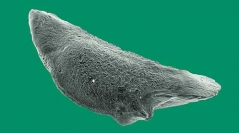

 Comptes Rendus Palevol
21 (36) - Pages 801-813
Comptes Rendus Palevol
21 (36) - Pages 801-813We report the first cephalopod statoliths from the Early Cretaceous. These unique microfossils fill the gap in the fossil record between Jurassic and Cenozoic forms, and are more similar to the former. We compare the morphology of the Mesozoic forms with the statoliths from Recent and Cenozoic decabrachians. This comparison shows the closest resemblance to the Recent Idiosepiidae. We suggest that Mesozoic cephalopod statoliths belong to the basal decabrachians and they are related to the idiosepiids. The belemnitid identity of these forms can be neither confirmed nor rejected though some positive correlation in the investigated materials between findings of belemnitid rostra and statoliths do occur. These finds support also some previous suggestions that decabrachians and vampyropods diverged earlier than in the Early Jurassic. We discuss the absence of the wing in the Mesozoic statoliths and suggest that the robustly developed spur could play a similar role to the wing in Cenozoic and Recent decabrachian statoliths. We suggest that the statolith morphology might be a useful tool to interpret cephalopod evolution. We also note an evident shift in the abundance ratio of statoliths vs fish otoliths, the former being dominant in the Jurassic while declining in abundance in the Cretaceous. This supports a Cretaceous turnover in several groups of marine organisms.
Statolith, Cretaceous, Valanginian, Aptian, Yorkshire, Speeton, Wąwał, Poland